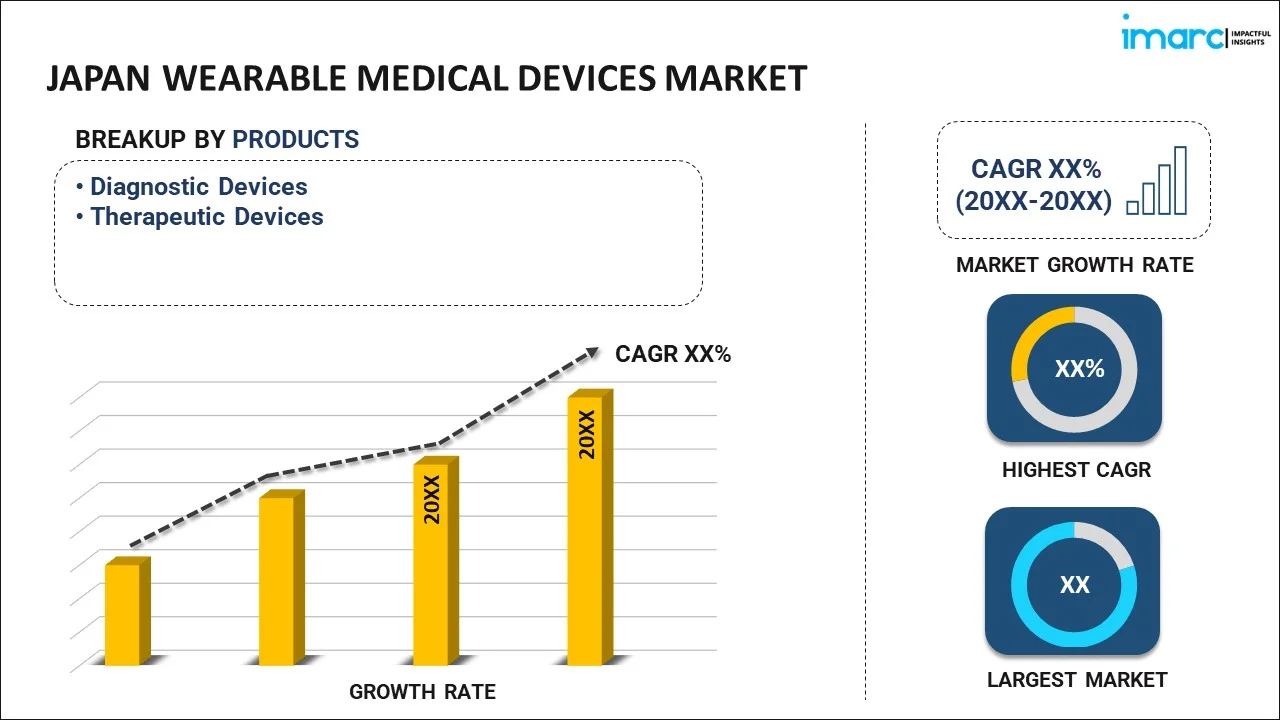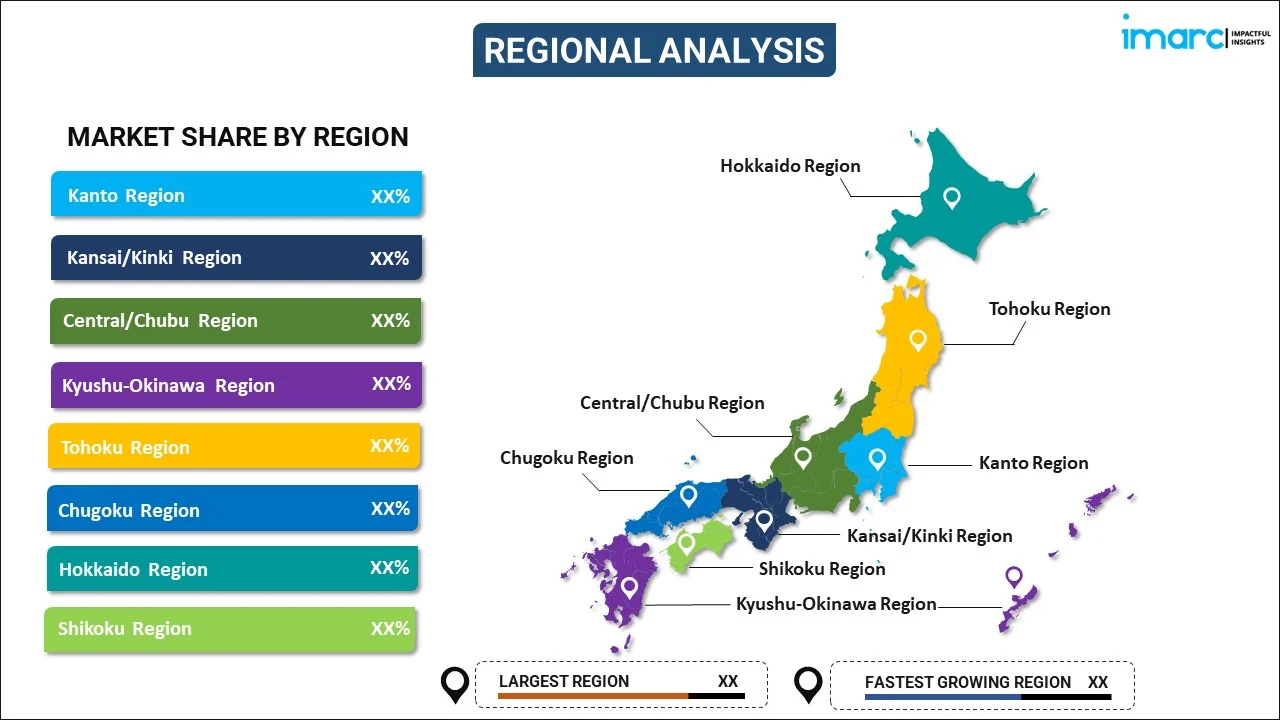
Japan Wearable Medical Devices Market Report by Product (Diagnostic Devices, Therapeutic Devices), Site (Handheld, Headband, Strap/Clip/Bracelet, Shoe Sensors, and Others), Application (Sports and Fitness, Remote Patient Monitoring, Home Healthcare), and Region 2025-2033
Market Overview:
Japan wearable medical devices market size reached USD 1.9 Billion in 2024. Looking forward, IMARC Group expects the market to reach USD 8.4 Billion by 2033, exhibiting a growth rate (CAGR) of 16.7% during 2025-2033. The market is being driven by significant factors, such as the growing incidence of chronic illnesses, a shifting focus towards remote patient monitoring and telehealth offerings, and the swift progress in technology, particularly in areas like sensors, wireless communication, and miniaturization.
|
Report Attribute
|
Key Statistics
|
|---|---|
|
Base Year
|
2024 |
|
Forecast Years
|
2025-2033
|
|
Historical Years
|
2019-2024
|
| Market Size in 2024 | USD 1.9 Billion |
| Market Forecast in 2033 | USD 8.4 Billion |
| Market Growth Rate (2025-2033) | 16.7% |
Wearable medical devices are independent tools designed for continuous medical monitoring or assistance, typically worn as accessories or integrated into clothing. They include noninvasive physiological sensors, wireless data transmission features, and components for medical feedback and data processing. In recent times, wearable medical devices have experienced significant adoption due to their capacity to complement the emerging healthcare trend of delivering point-of-care treatment. Additionally, they facilitate unobtrusive medical supervision and provide remote support for managing medical conditions, especially beneficial for the rehabilitation of individuals coping with chronic illnesses or disabilities.
Japan Wearable Medical Devices Market Trends:
The growing prevalence of chronic diseases like ischemic heart disease (IHD), stroke, and diabetes are increasingly emerging as the principal causes of mortality and morbidity. This health trend has triggered a surge in the utilization of wearable technology among individuals in Japan, enabling them to gather health-related data and monitor their well-being. Furthermore, the recent outbreak of the coronavirus disease (COVID-19) has spurred innovations in wearable medical devices tailored for telehealthcare, thereby enhancing the convenience, effectiveness, and adoption of home-based telemedicine. These devices offer the capability to monitor a wide range of physiologic data, including biopotential, photoplethysmogram (PPG), heart rate (HR), blood pressure (BP), blood oxygen saturation (SaO2), and respiration. Additionally, the heightened awareness of fitness among consumers has spurred the development of wearable devices such as smart bands and smartwatches in Japan. These devices leverage advanced technologies such as artificial intelligence (AI), cloud computing, machine learning, and big data analytics, enabling users to monitor various fitness parameters like step count, calorie expenditure, and distance covered. Furthermore, the Japan wearable medical devices market benefits from factors including an aging population, significant enhancements in healthcare infrastructure, and continual advancements in wearable technology. These factors is expected to contribute to the robust growth of the market in the coming years.
Japan Wearable Medical Devices Market Segmentation:
IMARC Group provides an analysis of the key trends in each segment of the market, along with forecasts at the country level for 2025-2033. Our report has categorized the market based on product, site, and application.
Product Insights:

- Diagnostic Devices
- Vital Sign Monitoring Devices
- Heart Rate Monitors
- Activity Monitors
- Electrocardiographs
- Pulse Oximeters
- Spirometers
- Blood Pressure Monitors
- Others
- Sleep Monitoring Devices
- Sleep trackers
- Wrist Actigraphs
- Polysomnographs
- Others
- Electrocardiographs Fetal and Obstetric Devices
- Neuromonitoring Devices
- Electroencephalographs
- Electromyographs
- Others
- Vital Sign Monitoring Devices
- Therapeutic Devices
- Pain Management Devices
- Neurostimulation Devices
- Others
- Insulin/Glucose Monitoring Devices
- Insulin Pumps
- Others
- Rehabilitation Devices
- Accelometers
- Sensing Devices
- Ultrasound Platform
- Others
- Respiratory Therapy Devices
- Ventilators
- Positive Airway Pressure (PAP) Devices
- Portable Oxygen Concentrators
- Others
- Pain Management Devices
The report has provided a detailed breakup and analysis of the market based on the product. This includes diagnostic devices [vital sign monitoring devices (heart rate monitors, activity monitors, electrocardiographs, pulse oximeters, spirometers, blood pressure monitors, and others), sleep monitoring devices (sleep trackers, wrist actigraphs, polysomnographs, and others), electrocardiographs fetal and obstetric devices, neuromonitoring devices (electorencephalographs, electromyographs, and others)], and therapeutic devices [pain management devices (neurostimulation devices and others), insulin/glucose monitoring devices (insulin pumps and others), rehabilitation devices (accelometers, sensing devices, ultrasound platform, and others), respiratory therapy devices (ventilators, positive airway pressure (PAP) devices), portable oxygen concentrators, and others)] .
Site Insights:
- Handheld
- Headband
- Strap/Clip/Bracelet
- Shoe Sensors
- Others
A detailed breakup and analysis of the market based on the site have also been provided in the report. This includes handheld, headband, strap/clip/bracelet, shoe sensors, and others.
Application Insights:
- Sports and Fitness
- Remote Patient Monitoring
- Home Healthcare
The report has provided a detailed breakup and analysis of the market based on the application. This includes sports and fitness, remote patient monitoring, and home healthcare.
Regional Insights:

- Kanto Region
- Kansai/Kinki Region
- Central/ Chubu Region
- Kyushu-Okinawa Region
- Tohoku Region
- Chugoku Region
- Hokkaido Region
- Shikoku Region
The report has also provided a comprehensive analysis of all the major regional markets, which include Kanto Region, Kansai/Kinki Region, Central/ Chubu Region, Kyushu-Okinawa Region, Tohoku Region, Chugoku Region, Hokkaido Region, and Shikoku Region.
Competitive Landscape:
The market research report has also provided a comprehensive analysis of the competitive landscape. Competitive analysis such as market structure, key player positioning, top winning strategies, competitive dashboard, and company evaluation quadrant has been covered in the report. Also, detailed profiles of all major companies have been provided.
Japan Wearable Medical Devices Market Report Coverage:
| Report Features | Details |
|---|---|
| Base Year of the Analysis | 2024 |
| Historical Period | 2019-2024 |
| Forecast Period | 2025-2033 |
| Units | Billion USD |
| Scope of the Report | Exploration of Historical and Forecast Trends, Industry Catalysts and Challenges, Segment-Wise Historical and Predictive Market Assessment:
|
| Products Covered |
|
| Sites Covered | Handheld, Headband, Strap/Clip/Bracelet, Shoe Sensors, Others |
| Applications Covered | Sports and Fitness, Remote Patient Monitoring, Home Healthcare |
| Regions Covered | Kanto Region, Kansai/Kinki Region, Central/ Chubu Region, Kyushu-Okinawa Region, Tohoku Region, Chugoku Region, Hokkaido Region, Shikoku Region |
| Customization Scope | 10% Free Customization |
| Post-Sale Analyst Support | 10-12 Weeks |
| Delivery Format | PDF and Excel through Email (We can also provide the editable version of the report in PPT/Word format on special request) |
Key Questions Answered in This Report:
- How has the Japan wearable medical devices market performed so far and how will it perform in the coming years?
- What has been the impact of COVID-19 on the Japan wearable medical devices market?
- What is the breakup of the Japan wearable medical devices market on the basis of product?
- What is the breakup of the Japan wearable medical devices market on the basis of site?
- What is the breakup of the Japan wearable medical devices market on the basis of application?
- What are the various stages in the value chain of the Japan wearable medical devices market?
- What are the key driving factors and challenges in the Japan wearable medical devices?
- What is the structure of the Japan wearable medical devices market and who are the key players?
- What is the degree of competition in the Japan wearable medical devices market?
Key Benefits for Stakeholders:
- IMARC’s industry report offers a comprehensive quantitative analysis of various market segments, historical and current market trends, market forecasts, and dynamics of the Japan wearable medical devices market from 2019-2033.
- The research report provides the latest information on the market drivers, challenges, and opportunities in the Japan wearable medical devices market.
- Porter's five forces analysis assist stakeholders in assessing the impact of new entrants, competitive rivalry, supplier power, buyer power, and the threat of substitution. It helps stakeholders to analyze the level of competition within the Japan wearable medical devices industry and its attractiveness.
- Competitive landscape allows stakeholders to understand their competitive environment and provides an insight into the current positions of key players in the market.
Need more help?
- Speak to our experienced analysts for insights on the current market scenarios.
- Include additional segments and countries to customize the report as per your requirement.
- Gain an unparalleled competitive advantage in your domain by understanding how to utilize the report and positively impacting your operations and revenue.
- For further assistance, please connect with our analysts.
 Inquire Before Buying
Inquire Before Buying
 Speak to an Analyst
Speak to an Analyst
 Request Brochure
Request Brochure
 Request Customization
Request Customization




.webp)




.webp)












